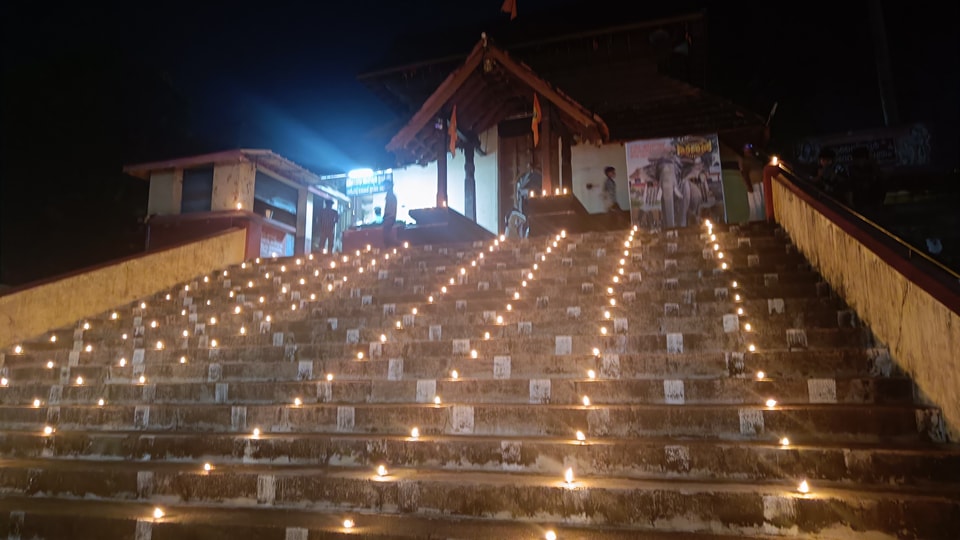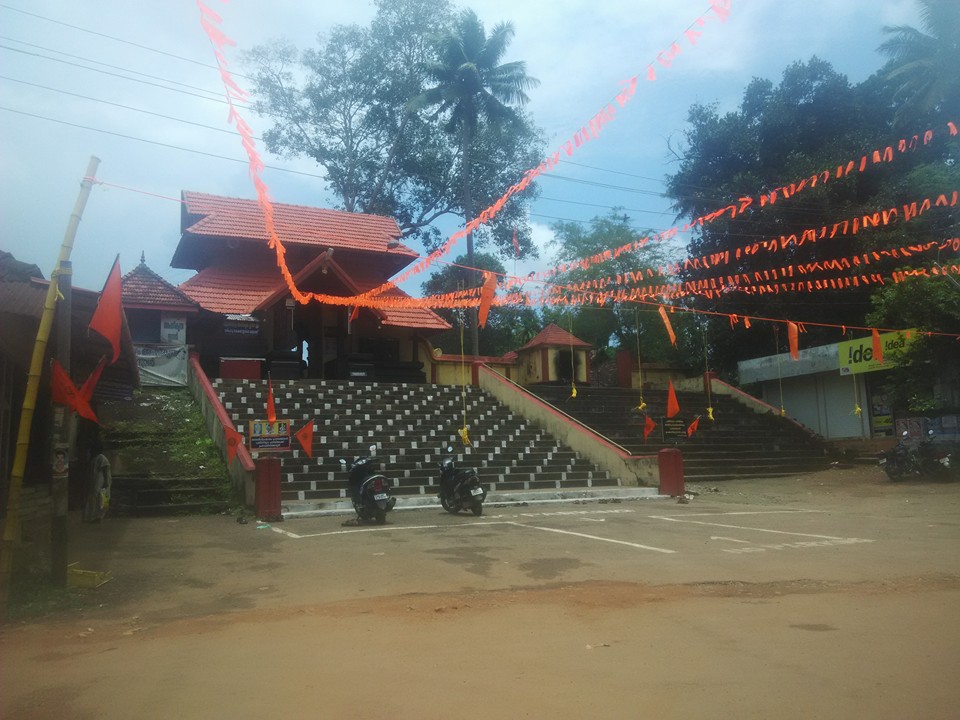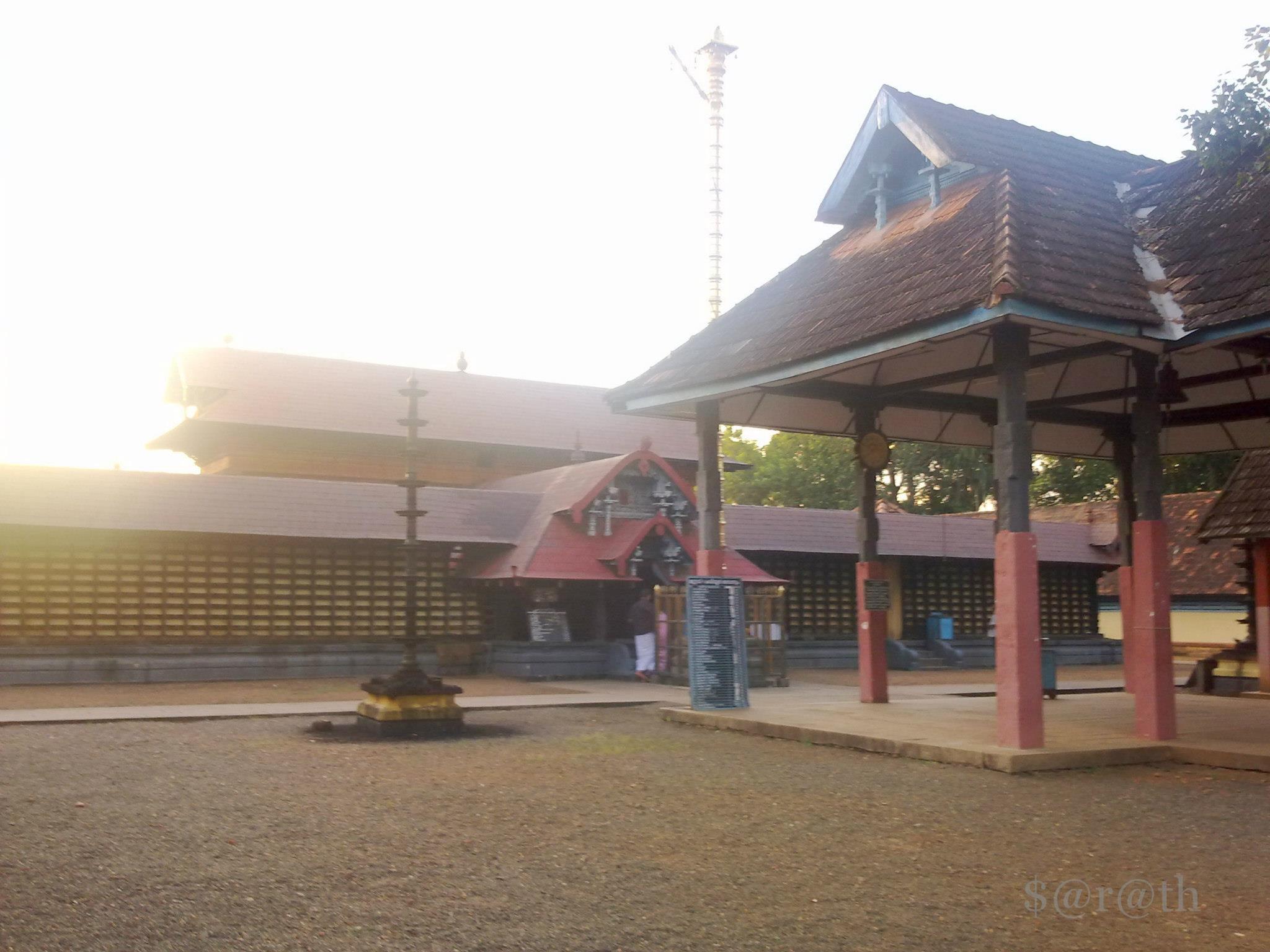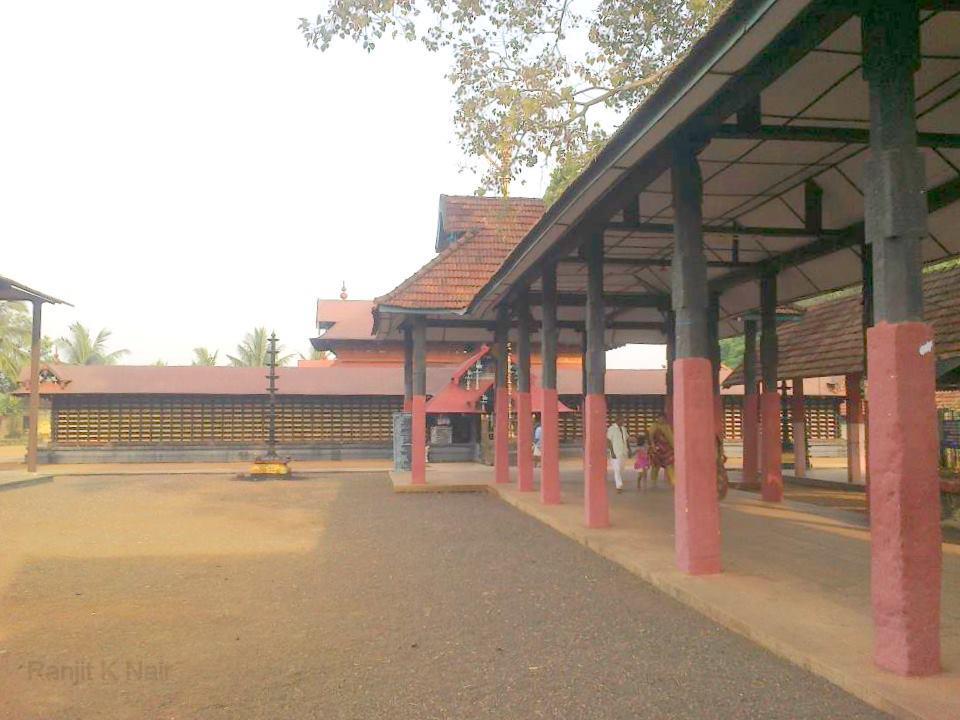Kaviyoor Mahadevar Temple is a significant Shiva temple situated in Kaviyoor, within the Tiruvalla region of Pathanamthitta District, Kerala, India. It is often referred to as Thrikkaviyoor Mahadeva Temple.

The principal deity of the temple is Lord Mahadeva (Shiva), accompanied by Parvathi. This temple is particularly renowned for the Hanuman temple located within its complex. Kaviyoor Temple holds significant status as one of the Special Grade temples under the Travancore Devaswom Board.
Kaviyoor Mahadevar Temple is positioned 200 meters to the west of Kaviyoor Junction along the Changancherry-Kaviyoor Road. While Lord Shiva is the main deity, the worship of Hanuman is also of considerable importance. The temple is approximately five kilometers from SCS Junction in Tiruvalla and is situated on a small hillock, accessible via 21 broad steps that lead to the impressive eastern Gopuram.
The main entrance opens into an extensive Anakkottil, and the eastern courtyard features a golden dhwaja (flagmast) flanked by two tall lamp-masts. The temple complex encompasses a fortified area of two acres. The outer wall, constructed from Laterite, stands at a moderate height and has been recently plastered with cement.
Historical records indicate that this wall is several centuries old. Gopurams are located on the southern and western sides of the structure, while a long Oottupura can be found on the northern side. Additionally, there is a pool designated for the priests situated in the northeast. Outside the temple complex, on the western side, lies the Keezhthrikkovil Maha Vishnu Temple. To the west, there is a large lake known as Polachira.
This lake was formerly associated with the Kaviyoor Temple but is now managed by the Fisheries Department, which operates an inland fish-seed farm in the area. The principal deity is referred to as Thrikkaviyoorappan. The Shivalinga is thought to be composed of sand and darbha grass. According to the dhyanasloka, Lord Shiva of Kaviyoor Temple is depicted in a serene form, seated in the lotus position (padmasana), with his left hand embracing Goddess Parvati, and is accompanied by his sons, Ganapathi and Subrahmanya.
The idols of Shiva as Dakshinamurthi and Ganapathi are positioned together on the southern side of the main sanctum. Lord Ayyappan is situated in the south-west, facing east. In the western section, Goddess Parvati is revered as Sreemoolarajeswari. This idol was consecrated in the year ME 1068 (AD 1893) under the directives of Maharaja Sri Moolam Thirunal Rama Varma of Travancore. Located in the north-west corner of the inner courtyard, outside the main sanctum, is the Hanuman temple. The idol here is small and also faces east, and this deity enjoys greater popularity than Lord Shiva.
On the northeast side of the outer courtyard, outside the nalambalam (cloister), there are installed idols of the serpent deities, Naga Raja and Naga Yakshi. The presiding deity of the Keezhthrikkovil Temple, located beneath the main temple complex on the northwest side, is Mahavishnu. The idol in this temple is crafted from stone and is depicted in a standing posture with four arms.
According to the legend, the principal idol of Lord Shiva was established by Lord Sri Rama in the presence of Sita, Hanuman, Sugreeva, and Vibheeshana upon his return to Ayodhya after vanquishing Ravana. Lord Sri Rama instructed Hanuman to retrieve a divine Sivalinga from the Himalayas. Hanuman diligently searched the Himalayas for a distinctive Sivalinga, which took considerable time. As the auspicious moment for the installation approached, Lord Rama decided to proceed with the Prathishta immediately. He fashioned a Sivalinga from the earth at that location and consecrated it. Upon his return, Hanuman felt disheartened to find that the Prathishta had already been completed.
In response, Lord Rama asked Hanuman to remove the existing installation and replace it with the divine Sivalinga he had brought. Despite Hanuman's utmost efforts, the newly created earthen Linga remained unchanged. Instead, the surrounding land elevated to form a small hillock. Consequently, Hanuman sought forgiveness and requested Lord Rama's permission to remain near the divine installation for eternity. Thus, Kaviyoor became Hanuman's abode, and it is traditionally recognized as the most significant Hanuman temple in South India.
A second legend pertains to the establishment of Hanuman prathishta within the temple complex. Sage Vilwamangalam once visited this temple, and upon entering the premises, he experienced a vision of Lord Hanuman perched on the branch of a large Ilanji (Mimusops elengi) tree located in the northeastern section of the outer courtyard. He beseeched the Lord to descend from the tree and take a comfortable position in the inner courtyard, close to Lord Shiva. Hanuman granted his request and settled on the sage's Japa-Kindi in the northwestern corner of the inner courtyard.
Subsequently, following a dream that appeared to Maharaja Chithira Thirunal Balarama Varma, a separate sanctum for Lord Hanuman was constructed in M.E. 1108 (AD 1934). Panthrantu Kalabham festival was inaugurated in 1951 in honor of Lord Hanuman, as per the wishes of Sri Chithira Thirunal Balaramavarma, to commemorate the renovation and enhancement of the Hanuman Temple. This festival commences on the first day of the Malayalam month of Chingam and concludes on the twelfth day. The Ayilyam, observed in the Malayalam month of Kanni, is dedicated to the serpent deities.
The principal festival honoring Lord Mahadeva occurs during the Malayalam month of Dhanu (December-January) and draws thousands of devotees from across the central Travancore region, lasting for ten days. During the festival, the idol of the deity is paraded on a richly adorned elephant to various locations associated with the temple from the second to the sixth day. From the seventh day onward, the rituals are confined to the temple grounds. On the tenth day, the idols of Lord Shiva and Goddess Parvathi are carried in a grand procession to the Manimala River for the Arat ceremony.
There is an additional annual festival observed during the Malayalam month of Dhanu (December–January) associated with the Hanuman temple, known as Hanumath Jyanthi. This event draws thousands of devotees. In the month of Makaram (January–February), the Uthrittathi thirunal is commemorated to honor the consecration of the Sri Moolarajeswary idol. The month of Kumbham (February–March) features the celebration of Shivarathri, which includes various rituals. During this time, 8000 lamps adorning the walls of the Nalambalam are lit by seven regions from the villages of Kaviyoor and Kunnamthanam.
The Sahasrakalasam festival holds significant importance and spans 11 days, having commenced in ME1082 (AD 1907). The primary offerings dedicated to Lord Shiva include Dhara, Payasam, Atimakitaththal, and Thulabharam. In contrast, the principal offerings for Hanuman at this temple consist of Aval Panthirunazhi and Vadamala.
Both of these offerings require prior reservations; however, small packets of aval nivedyam can be obtained from the counter at any time. For Mahavishnu, the main offering is palppayasam. Additionally, various common offerings such as Ganapati Homan and other Hindu rituals are also conducted at this temple.
കവിയൂർ മഹാദേവ-ഹനുമാൻ ക്ഷേത്രം
തൃക്കവിയൂർ ശ്രീമഹാദേവക്ഷേത്രം പത്തനംതിട്ട ജില്ലയിലെ കവിയൂരിൽ സ്ഥിതിചെയ്യുന്ന ഒരു ചരിത്രപ്രസിദ്ധമായ മഹാക്ഷേത്രമാണ്. തിരുവിതാംകൂർ ദേവസ്വം ബോർഡിന്റെ കീഴിലുള്ള പ്രധാന സ്പെഷ്യൽ ഗ്രേഡ് ദേവസ്വങ്ങളിലൊന്നായി ഇത് കണക്കാക്കപ്പെടുന്നു. വാസ്തുശില്പത്തിന്റെ പ്രത്യേകതകൾ അടിസ്ഥാനമാക്കി, കേരളത്തിലെ ഏറ്റവും പുരാതനമായ മഹാക്ഷേത്രങ്ങളിൽ ഒന്നായി ഗവേഷകർ ഈ ക്ഷേത്രത്തെ വിശേഷിപ്പിക്കുന്നു.
പ്രധാന ശ്രീകോവിലിന്റെ അടിത്തറയിൽ കാണപ്പെടുന്ന കലിവർഷം 4051, 4052 (എ.ഡി. 951, 952) വർഷങ്ങളിലെ ശിലാശാസനങ്ങൾ ചരിത്രപരമായ പ്രാധാന്യം കൈവശം വഹിക്കുന്നു. പാർവതിയെ ഇടതുവശത്തിരുത്തി സർവമംഗളമൂർത്തിയായ മഹാദേവനാണ് പ്രധാന പ്രതിഷ്ഠ. ത്രേതായുഗത്തിൽ ശ്രീരാമൻ പ്രതിഷ്ഠിച്ച ശിവലിംഗമാണിതെന്ന് വിശ്വസിക്കപ്പെടുന്നു.
നാലമ്പത്തിന്റെ വടക്കുപടിഞ്ഞാറെ കോണിൽ സ്ഥിതിചെയ്യുന്ന ഹനുമാൻസ്വാമി ക്ഷേത്രം പ്രശസ്തമാണ്. പ്രാചീനകാലത്ത് ഒരു ഉപദേവതയായി മാത്രം പരിഗണിക്കപ്പെട്ട ഹനുമാൻ, ഇന്ന് മഹാദേവനേക്കാൾ കൂടുതൽ പ്രാധാന്യമുള്ളവനായി ക്ഷേത്രത്തിൽ പ്രത്യക്ഷപ്പെടുന്നു. ഇവരോടൊപ്പം ഗണപതി, ദക്ഷിണാമൂർത്തി, നാഗദൈവങ്ങൾ, യക്ഷി എന്നിവയും ക്ഷേത്രത്തിൽ കാണപ്പെടുന്നു, കൂടാതെ മഹാവിഷ്ണുവിനും പ്രത്യേക സ്ഥാനം ഉണ്ട്. കവിയൂർ മഹാദേവർക്ഷേത്രം ചങ്ങനാശ്ശേരി-കോഴഞ്ചേരി റോഡിൽ, കവിയൂർ ജംഗ്ഷനിൽ നിന്ന് ഇരുനൂറു മീറ്റർ പടിഞ്ഞാറായി സ്ഥിതിചെയ്യുന്നു.
റോഡരികിൽ, മുപ്പതുകൊല്ലം മുമ്പ് നിർമ്മിച്ച അലങ്കാര ഗോപുരം കാണാം. കിഴക്കേ നടയിൽ ഒരു വിശാലമായ കുളം ഉണ്ട്. ഇരുപത്തിയൊന്ന് നെടുനീളൻ പടവുകൾക്കു മുകളിൽ ഉയർന്നിരിക്കുന്ന ഗംഭീര ഇരുനില ഗോപുരം, ക്ഷേത്രത്തിന്റെ വാസ്തുശില്പത്തിന്റെ മഹത്വം പ്രകടിപ്പിക്കുന്നു. കിഴക്കേ ഗോപുരവാതിൽ കടന്നാൽ, സുദീർഘമായ ആനക്കൊട്ടിലിലേക്ക് പ്രവേശിക്കാം. സ്വർണ്ണക്കൊടിമരത്തിന് 21 പറകളുണ്ട്. കരിങ്കൽ പാകിയിട്ടുള്ള പ്രദക്ഷിണവഴി ക്രമീകരിച്ചിരിക്കുന്നു. വിശാലമായ നാലമ്പലം, വിളക്കുമാടം, വാതിൽമാടം, നമസ്കാരമണ്ഡപം, ശ്രീകോവിലുകൾ എന്നിവയെല്ലാം ചെമ്പുമേഞ്ഞിരിക്കുന്നു.
വിളക്കുമാടത്തിൽ ഏഴായിരത്തിലധികം വിളക്കുകൾ സ്ഥാപിച്ചിരിക്കുന്നു. ചതുരാകൃതിയിലുള്ളതാണ് നമസ്കാരമണ്ഡപം. നാലമ്പലത്തിന്റെ വടക്കു-പടിഞ്ഞാറെ മുലയിൽ ആറടി സമചതുര ശ്രീകോവിലിൽ ഹനുമാൻ ക്ഷേത്രം സ്ഥിതിചെയ്യുന്നു. മതിൽക്കെട്ടിന് വെളിയിൽ പടിഞ്ഞാറുവശത്ത് താഴെയായി കീഴ്തൃക്കോവിൽ ക്ഷേത്രം. അതിനും പിന്നിലായി വിശാലമായ പോളച്ചിറ ജലാശയം കാണാം.
രാമേശ്വരം ക്ഷേത്രത്തിന്റെ ഉദ്ഭവകഥയുമായി സാദൃശ്യമുള്ള ഒരു കഥയാണ് കവിയൂർ ക്ഷേത്രത്തിനും. രാവണവധം കഴിഞ്ഞ് സീതാ-ലക്ഷ്മണന്മാർക്കും വാനര- രാക്ഷസപ്പടകളോടുമൊപ്പം അയോദ്ധ്യയിലേയ്ക്ക് മടങ്ങും വഴി ശ്രീരാമൻ പ്രതിഷ്ഠിച്ചതാണ് ഇവിടുത്തെ ശിവലിംഗം എന്നാണ് ഐതിഹ്യം. അശോകവിമാനത്തിലിരുന്ന് താഴെയുള്ള പ്രദേശത്തിന്റെ മനോഹാരിതയിൽ മുഴുകിയ സീതയുടെ ആഗ്രഹപ്രകാരമാണ് പുഷ്പകവിമാനത്തിൽ പറക്കുന്ന ശ്രീരാമനും പരിവാരങ്ങളും കവിയൂരിലിറങ്ങിയതത്രേ.
ശിവപ്രതിഷ്ഠയ്ക്ക് ഉത്തമസ്ഥലമാണെന്നു കണ്ട് ശ്രീരാമൻ ഉത്തമശിവലിംഗം കണ്ടെടുത്തുവരുവാൻ ഹനുമാനെ നിയോഗിച്ചു. ശുഭമുഹൂർത്തം എത്തിയിട്ടും ഹനുമാൻ മടങ്ങിവരാതിരുന്നതിനാൽ മണ്ണും ദർഭയും ചേർത്ത് ഒരു ശിവലിംഗം നിർമിച്ച് രാമൻ പ്രതിഷ്ഠ നിർവഹിച്ചു. മടങ്ങിയെത്തിയ ഹനുമാൻ തന്റെ പ്രയത്നം വിഫലമായതിൽ ഖിന്നനായി എന്നും മനസ്സിലാക്കിയ രാമൻ താൻ പ്രതിഷ്ഠിച്ച ശിവലിംഗം മാറ്റി ഹനുമാൻ കൊണ്ടുവന്നത് പ്രതിഷ്ഠിച്ചുകൊള്ളുവാൻ പറഞ്ഞു.
അതിശക്തനായ ഹനുമാൻ, രാമൻ സ്ഥാപിച്ച ശിവലിംഗത്തെ ചലിപ്പിക്കാൻ പോലും സാധിച്ചില്ല. ശ്രീരാമൻ സ്ഥാപിച്ച ക്ഷേത്രത്തിന്റെ മഹത്ത്വം മനസ്സിലാക്കിയ ഹനുമാൻ, അദ്ദേഹത്തിന്റെ അനുമതിയോടെ ആ സന്നിധിയിൽ നിത്യവാസം ആരംഭിച്ചു. അതിനാൽ ആ പ്രദേശം കപിയൂർ (കപിയുടെ ഊർ) എന്ന പേരിൽ അറിയപ്പെടുകയും, പിന്നീട് കപിയൂരു എന്ന പേരിൽ ലോപിച്ച് കവിയൂരായി മാറിയെന്നു പറയപ്പെടുന്നു.
നൂറ്റാണ്ടുകൾക്കുശേഷം ദിവ്യമായ കവിയൂർ ക്ഷേത്രത്തിൽ ദർശനം നടത്തിയ വില്വമംഗലം സ്വാമിയാർ, മതില്ക്കകത്തെ ഇലഞ്ഞിയിൽ ഹനുമാന്റെ സാന്നിധ്യം കാണുകയും, നാലമ്പത്തിന്റെ വായൂക്കോണിൽ ജപക്കിണ്ടികമിഴ്തിവച്ച് ഹനുമാനെ അവിടെ കുടിയിരുത്തുകയും ചെയ്തുവെന്നാണ് മറ്റൊരു ഐതിഹ്യം. ഇങ്ങനെ ഹനുമാൻ സ്വാമിയുടെ പ്രതിഷ്ഠ നാലമ്പലത്തിനകത്താണ് നടന്നത്. പിന്നീട്, ചിത്തിര തിരുനാൾ ബാലരാമവർമ്മയുടെ കാലത്ത്, അദ്ദേഹത്തിന് ഉണ്ടായ സ്വപ്നദർശനത്തിൽ കണ്ടതനുസരിച്ച്, ഇപ്പോഴത്തെ പടിത്തരങ്ങൾ സ്ഥാപിക്കാൻ തുടക്കം കുറിക്കുകയുണ്ടായി.
മഹാദേവനാണ് മുഖ്യപ്രതിഷ്ഠ, പാർവതീസമേതനായി ആനന്ദഭാവത്തിൽ ഇരിക്കുന്നവൻ. ഇടതുവശത്തുള്ള പാർവതിയെ ഇടതുകരം കൊണ്ട് ചേർത്തുപിടിച്ച്, വലതുകൈയിൽ വരദാനമുദ്രയോടും, മറ്റ് രണ്ടുകൈകളിൽ മാൻ, മഴു എന്നിവ കൈവശം വഹിച്ചും പദ്മാസനത്തിൽ ഇരിക്കുന്നതായാണ് പ്രതിഷ്ടാസങ്കൽപം. രണ്ടരയടിയോളം ഉയരമുള്ള ശിവലിംഗം മണ്ണും ദർഭയും ചേർത്ത് നിർമ്മിച്ചതാണെന്ന് വിശ്വസിക്കപ്പെടുന്നു. കിഴക്കോട്ട് ദർശനമായാണ് ശിവപ്രതിഷ്ഠ സ്ഥിതി ചെയ്യുന്നത്. പ്രതിഷ്ടയോടനുബന്ധിച്ച് ഹനുമാൻ നടത്തിയ ബലപ്രയോഗത്തിന്റെ അടയാളമായി വിഗ്രഹത്തിൽ വാൽ ചുറ്റിയ പാടുകൾ ഉണ്ടെന്നും വിശ്വസിക്കുന്നു.
തൃക്കവിയൂരപ്പൻ എന്ന പേരിൽ പുരാതനകാലം മുതൽ കവിയൂർ മഹാദേവൻ അറിയപ്പെടുന്നു. ആയിരത്തി ഒരുനൂറു കൊല്ലം മുമ്പുള്ള ശാസനയിൽ 'തിരുക്കവിയൂർത്തേവർ' എന്ന പേരിൽ സൂചന ലഭിക്കുന്നു. മഹാദേവനാണ് മുഖ്യപ്രതിഷ്ഠ, പാർവതീസമേതനായി ആനന്ദഭാവത്തിൽ ഇരിക്കുന്നവൻ. ഇടതുവശത്തുള്ള പാർവതിയെ ഇടതുകരം കൊണ്ട് ചേർത്തുപിടിച്ച്, വലതുകൈയിൽ വരദാനമുദ്രയോടും, മറ്റ് രണ്ടുകൈകളിൽ മാൻ, മഴു എന്നിവ കൈവശം വഹിച്ചും പദ്മാസനത്തിൽ ഇരിക്കുന്നു.
രണ്ടരയടിയോളം ഉയരമുള്ള ശിവലിംഗം മണ്ണും ദർഭയും ചേർത്ത് നിർമ്മിച്ചതാണെന്ന് വിശ്വസിക്കപ്പെടുന്നു. കിഴക്കോട്ട് ദർശനമായാണ് ശിവപ്രതിഷ്ഠ സ്ഥിതിചെയ്യുന്നത്. പ്രതിഷ്ടയോടനുബന്ധിച്ച് ഹനുമാൻ നടത്തിയ ബലപ്രയോഗത്തിന്റെ അടയാളമായി വിഗ്രഹത്തിൽ വാൽ ചുറ്റിയ പാടുകൾ ഉണ്ടെന്നും വിശ്വസിക്കുന്നു. തൃക്കവിയൂരപ്പൻ എന്ന പേരിൽ പുരാതനകാലം മുതൽ കവിയൂർ മഹാദേവൻ അറിയപ്പെടുന്നു. ആയിരത്തി ഒരുനൂറു കൊല്ലം മുമ്പുള്ള ശാസനയിൽ 'തിരുക്കവിയൂർത്തേവർ' എന്ന പേരിൽ സൂചന ലഭിക്കുന്നു.
അറുനൂറു കൊല്ലം മുമ്പുള്ള രേഖകളിൽ തൃക്കവിയൂരപ് എന്ന പേരും കാണപ്പെടുന്നു. വർഷം തോറും ധനുമാസത്തിലെ (ഡിസംബർ-ജനുവരി) തിരുവാതിരനാളിൽ കൊടിയേറി പത്തുദിവസം നീളുന്ന ഉത്സവം ആഘോഷിക്കുന്നു. രണ്ടുമുതൽ ആറുവരെയുള്ള ഉത്സവദിനങ്ങളിൽ ക്ഷേത്രം വകദേശവഴികളിലേയ്ക്ക് ഊരുവലത്തെഴുന്നള്ളത്ത് നടക്കുന്നു. ഏഴ്, എട്ട്, ഒൻപത് ദിവസങ്ങളിൽ അനുഷ്ഠാനപരമായ വേലകൾ, കാഴ്ചശ്രീബലി, സേവ എന്നിവ നടക്കുന്നു. കവിയൂരിലെ പള്ളിവേട വളരെ പ്രശസ്തമാണ്.
മധ്യതിരുവിതാംകൂറിന്റെ വിവിധ ഭാഗങ്ങളിൽ നിന്നുള്ള അനേകായിരം ആളുകൾ പള്ളിവേട്ടദിനത്തിലെ എഴുന്നള്ളിപ്പുകൾക്ക് സാക്ഷ്യം വഹിക്കാൻ എത്തുന്നു. തനിത്തങ്കത്തിൽ തീർത്ത നെറ്റിപ്പട്ടങളും ചട്ടങ്ങളും അന്നത്തെ എഴുന്നള്ളത്തിനുപയോഗിക്കുന്നു. പത്താം ദിവസം മണിമലയാറ്റിലെ പാറപ്പുഴക്കടവിൽ ആറാട്ടോടെ ഉത്സവം സമാപിക്കുന്നു.
ധനുമാസത്തിലെ മൂലം ദിനത്തിൽ ഹനുമദ് ജയന്തി ആഘോഷിക്കുന്നു. ഈ ആഘോഷത്തിന് ഏഴുദിവസത്തെ ചടങ്ങുകൾ ഒരുക്കിയിട്ടുണ്ട്. ഏഴാം ദിവസത്തിൽ കളഭാഭിഷേകം, പുഷ്പഘോഷയാത്ര, പുഷ്പാഭിഷേകം എന്നിവ നടക്കും. ആയിരത്തിത്തൊള്ളായിരത്തി അന്പതുകളിലാണ് ഈ ഉത്സവം ആരംഭിച്ചത്. രാത്രി വളരെ വിപുലമായ അനുഷ്ഠാനങ്ങളോടെ ആഘോഷങ്ങൾ നടത്തപ്പെടുന്നു.
അർദ്ധയാമപൂജയ്ക്കു ശേഷം നടക്കുന്ന വിളക്കിനെഴുന്നള്ളിപ്പിന്, ക്ഷേത്രത്തിന്റെ അധീനതയിലുള്ള എട്ടുകരകളുടെ പ്രതിനിധികൾ ചേർന്ന് ദീപക്കാഴ്ച ഒരുക്കും. വർഷംതോറും ഇടവമാസത്തിലെ (മെയ്-ജൂൺ) വെളുത്തപക്ഷദ്വാദശി മുതൽ പതിനൊന്നുദിവസം നീളുന്ന ഒരു ഉത്സവമാണ് ഇത്. പത്തുദിവസം കലശാഭിഷേകവും, പതിനൊന്നാമത്തെ ദിവസം കളഭാഭിഷേകവും നടത്തപ്പെടുന്നു. ദിവസേന നടക്കുന്ന അഭിഷേകങ്ങൾക്കായി ജലം തൊണ്ണൂറ് ചെമ്പുകുടത്തിലും പത്തുവെള്ളിക്കുടത്തിലും ഒരു സ്വർണ്ണക്കുടത്തിലുമാണ് പൂജിക്കുന്നത്. പതിനൊന്നാമത്തെ ദിവസം ഉദയാസ്തമനപൂജയും ആനപ്പുറത്തു ശ്രീബലികളും ഉണ്ടാകും.
കൊല്ലവർഷം 1082-ൽ (1905) ക്ഷേത്രത്തിന്റെ വക ഭൂമികളിൽ നിന്നുള്ള ആഞ്ഞിലിത്തടികൾ വെട്ടി വിറ്റതിലൂടെ ലഭിച്ച 10744 രൂപ ട്രഷറിയിൽ നിക്ഷേപിച്ചതിന്റെ പലിശകൊണ്ട് ഈ ഉത്സവം നടത്തപ്പെടുന്ന രീതിയിലാണ് ആരംഭിച്ചത്. ശിവക്ഷേത്രത്തിലെ പ്രധാന വഴിപാടുകൾ ധാര, മുഴുക്കാപ്പ്, പായസം, അടിമകിടത്തൽ എന്നിവയാണ്. ഹനുമാൻ സ്വാമിയ്ക്ക് മുഖ്യവഴിപാടുകൾ അവൽപന്തിരുനാഴിയും വടമാലയുമാണ്.
Address:
Thottabhaghom- Kaviyoor Road,
Kaviyoor,
Thiruvalla, Kerala 689105



